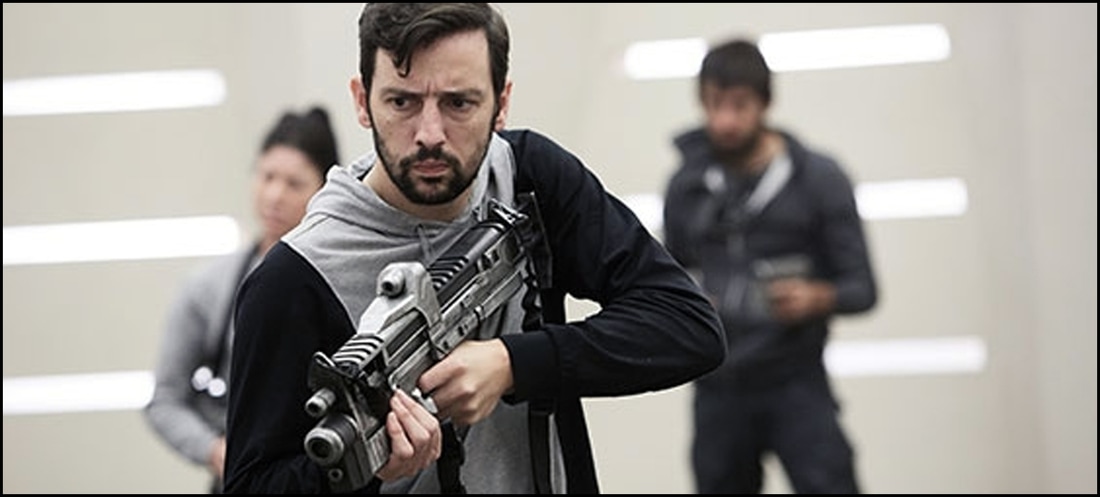While still getting to know one another, the Doctor and Bill conspire to escape the hum drum of their present-day circumstance with a quick trip to the tomorrow. There, they find a beautiful city curiously void of human life, and in its place a veritable army of emoji-expressive androids willing to provide for their every need. The catch? You must remain happy for any other unwelcome emotions will force the automatons to reduce the sufferer to dust, bones, and fertilizer. Despite the circumstances, it’s a delightful hour that gives the Doctor and his newest companion a chance to work out the kinks of their ‘Abbott & Costello’ routine while staying alive and guaranteeing peace for an all-new race of man (or a reasonable facsimile thereof.)
Why?
Well, for starters the true lion's share of the action involves solely Capaldi and Who newcomer Pearl Mackie (as Bill). In a clinical sense, these two are still getting to know one another -- both on the page and off -- and you have to give major kudos to the talent on-screen and behind it to deliver so winning a combination as is demonstrated here. You have to be listening closely to know just how 'fresh' these two are to each other as their chemistry as a time-and-space-travelling duo works quite well from start to finish. The relationship is set in stone, largely thanks to decades of previous companions, but its the chemistry that makes it all palpable.
A lesser show would've stuck this hour later in its production schedule, giving the principals more time to not so much as to acclimate to one another's quirks. But not Who. Who requires them to be at the top of their game each and every hour, and that's a testament to both great acting as it is solid writing.
Essentially, a fundamental misperception about the human experience fuels the Vardy storyline: because they’ve misinterpreted data to the point of believing anyone found unhappy needs to be eliminated from this future Utopia these bots become genocidally-driven Frankensteins. I suppose there’s a message in there for today’s technologically savvy generation. You know the ones? Those driven by ‘likes’ and ‘dislikes’ and ‘favorites’ on Facebook, Instagram, and Twitter? “Be wary of what you desire,” so the moral goes, “or you shall perish from it.” Under Doctor Who’s sugary packaging, that message certainly isn’t hard to swallow, and it goes down with the same ease as a jelly bean.
As is his drive, the time traveler from Gallifrey is quick with a solution, so much so that even he early on “misinterprets the signs” to mean something other than what they truly do, positioning him and Bill with nearly annihilating an entire ship and its cryogenically sleeping crew by accident. (Oddly enough, that turn of events would’ve wiped out not only Earth’s last survivors but also the Vardy, which turns out to be a newly sentient race.) It takes the face of a young boy – one of the earliest to wake up from his technological slumber – for the Doctor to see the error of his ways and to put the tale on course for a more amicable solution.
Granted, there are hints of what caused our world’s demise but nothing glaringly specific as instead a helpful montage makes it look like a death suffered from ‘a thousand cuts.’ Some might argue that the cause isn’t so important as is the reality that the Big Blue Marble is dead, but call me naïve if you will for wanting a bit more undiluted closure. All too often, SciFi defends the negative – the end of civilization – by casually and somewhat callously blaming mankind for all that ails us, but we’re just as likely to be bombarded by an extinction-level-event brought on by nature so long as we make it through our own worst propaganda. Indeed, it would look these survivors haven’t learned much since the first they do when facing a threat on this new world is to reach for their guns; and the Doctor pretty much leaves then there to work out the particulars of a treaty with these emoji-driven bots in the grand finale.
Another bone of contention? Well, I’ve grew weary long ago of spacecraft interiors looking more like a souped-up factory in Newcastle. Thematically, it made a bit more sense in “Smile” as the crude, industrial look serves a visual counterpoint to the stylized, antiseptic corridors built and manned by robots, but it was still a bit disappointing. All-in-all, I suspect this is owed as much to budgetary constraints as it is any other influence.
Lastly, there are still a few existing breadcrumbs dropped along the way, hints to greater events perhaps at work in this last season for Capaldi. Thankfully, most of them appear in the opening segments in the TARDIS, allowing much of this hour to function independently for newcomers to the franchise. It would seem that showrunner Steven Moffat is sticking to his pledge to make Who easier for new fans to board the popular program as even he is looking toward his exit at the end of this season. I remain one fan happy for Who to weave more stand-alone stories as I think the reliance on too much background makes for occasionally muddled storytelling.





 RSS Feed
RSS Feed